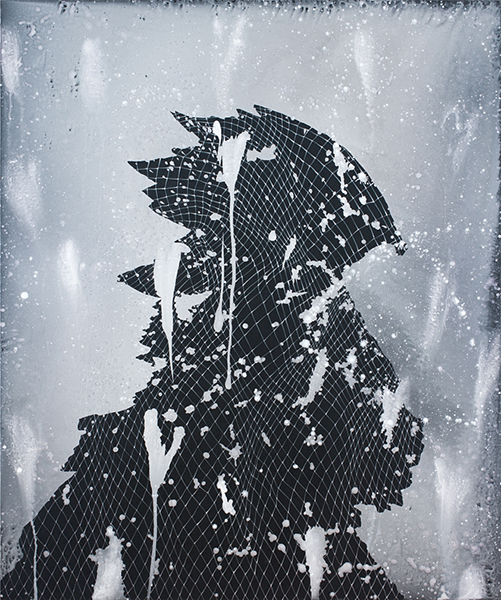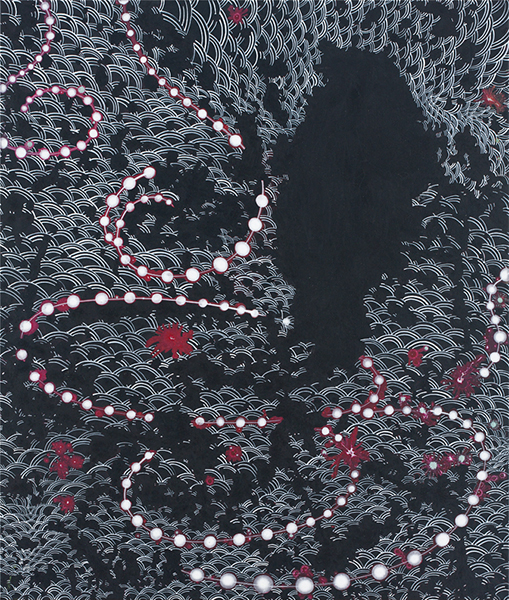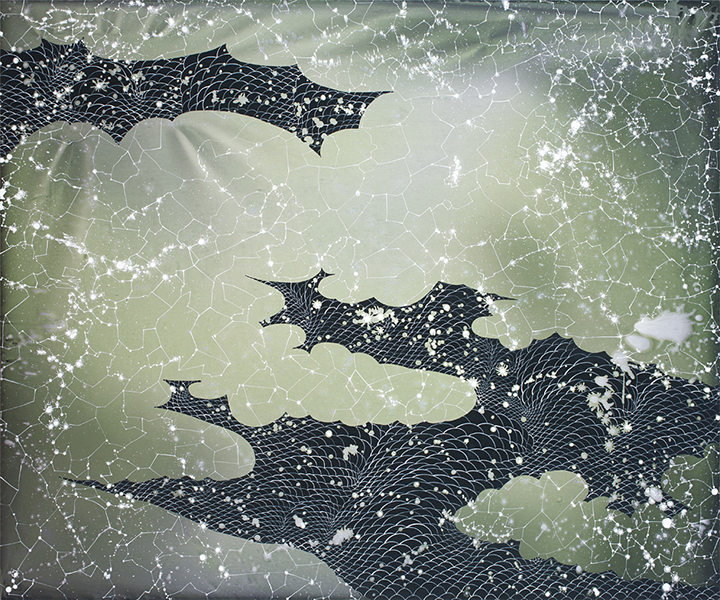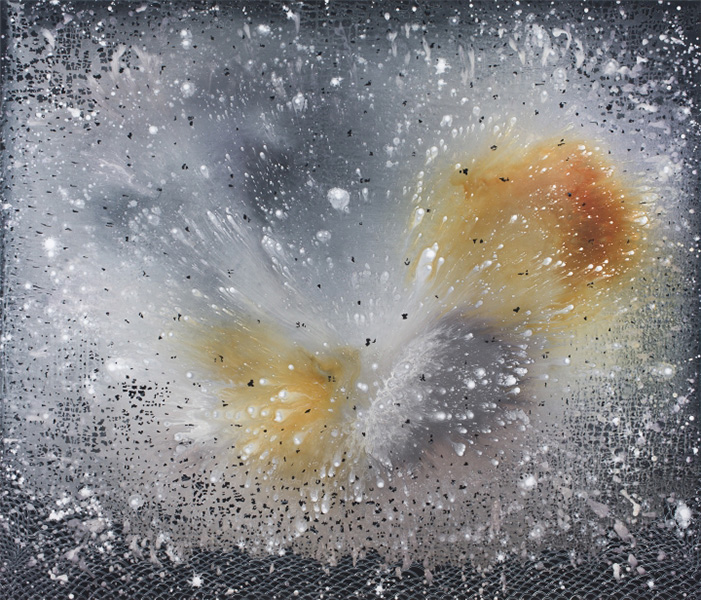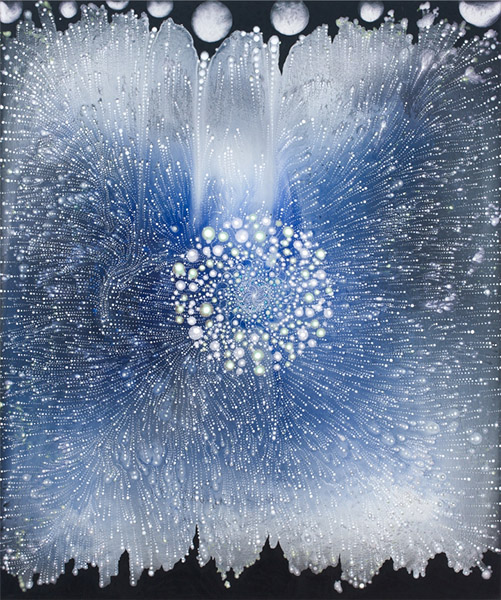
September 3, 2018
Studio visit with Barbara Takenaga
Contributed by Leslie Wayne / Barbara Takenaga has been pitting her skill at painting pattern against the physical constraints of materials for years, and her skill has usually won out. For a long time, bodies of work based on the Mandala were her signature motif. She meticulously painted carefully plotted circular patterns with the devotion of a Buddhist monk. Then she abruptly shifted, not only in her approach to process but in size and scale. What has happened in the last three shows since she started exhibiting with DC Moore Gallery is a deliberate privileging of chance. This has not in any way diminished her labor-intensive process. In fact, labor in a way has taken on a greater role, though in such a sly and sophisticated manner that you would never know that, for example, she painted what you think is the background last instead of first. Does it matter that one is painted over the other? Not in terms of the work’s conceptual underpinnings. Only to Barbara, whose love of the labor itself is close to sacrosanct.
If you were to ask her what the overall conceptual framework was behind her painting, she would defer to process. She in fact calls herself a process painter, someone dealing improvisationally with order and chance. But based on this very commanding new body of work, I would suggest that powerful and durable emotional and intellectual forces, however subliminal, also play a role in her art making. These influences include her personal history and of the current state of national affairs. One doesn’t need to be truly old, which in today’s terms can verge on 100, to feel the weight of mortality and the pressures of time. One also need not be a bleeding-heart liberal to feel the intense anxieties of this political moment. Both these factors have converged on Takenaga, and the results are unexpected and arresting.
My recent visit to her studio gave us a chance to talk about these issues in anticipation of her upcoming solo show, “Outset,” her fourth at DC Moore.
Leslie Wayne: Barbara, I see how you’ve been slowly moving away from a centralized pattern over the years as the dominant characteristic of your paintings. And that’s true here too. But there are a couple of other things going on in this new body of work that are stunning. For one, your palette is much more restricted. For another, you’ve introduced in some of these paintings some singular and rather mysterious forms. What’s going on here?
Barbara Takenaga: Oh, yes, the palette is mainly black, white, gray and blue. In fact, the first working title was “Blue and Black.” I had been looking at a lot of books on Japanese and Indian painting and was enticed by the wonderful flat black shapes – a draped robe, elaborate hair styles, a winding river, the backs of elephants submerged in water. The shapes became silhouettes, separated from their context, abstracted to a place where they open up to other associations. A black figure turned on its side becomes a menacing cloud or an island or a big weird fish. And a lot of times the positive/negative spaces slide around because they’re less tied to a narrative. Is it cloud, land, constellation or does the foreground flip to a river, net or monster? I like that in between-ness. And I like that you called them “mysterious” because it enhances that aspect. What is that thing? For instance, the silhouette in the painting, Shadow Lovecame from a bit of peeling paint above the trash cans in my apartment building. I would walk past it every day and I fell in love with that image. It’s the absence of paint and a character. And a random encounter.
I didn’t really answer your question about the palette, did I? I want the work to be elegant, a little disturbing, a little funny, and have some weight. It didn’t initially occur to me that the palette was limited, but I think your thoughts about mortality and our particularly infuriating times in 2018 are in there. I’ve always felt that the invisible core of my art making is a struggle with change, which is essentially death, successive little ones and big ones. Between control and the passing of time. A futile attempt to hold on and let go simultaneously. Stuff we all know. I think about it a lot even though it’s not that apparent in the work. Wow, we really jumped into it all – in the first question even.
LW: Yes we did! So let’s backtrack a little. Your palette includes one other very prominent characteristic, which you didn’t mention – the use of interference colors. It’s very hard to incorporate those without taking on a kitschy quality, but to your credit, you’ve managed to use them in a way that mimics, or at least references the use of gold and silver in traditional Japanese art, particularly scrolls and screens. Were you aiming for that?
BT: Not in a conscious way, but I like that you pointed that out. It’s definitely there. I initially started using gold leaf in my small paintings in 2001 after a trip to Venice. That, plus an interest in how the Egyptians thought of gold, wanting to take it into the afterlife because it never changes, never corrodes. The vampire of metals. That desire to hold still in time. But gold leaf was tricky to paint on so I switched to acrylic iridescent paint. Not nearly as visually seductive – gold leaf wants to sit up on the top surface and flaunt itself – but definitely more of our time. And cheaper. And a little goofier because of that kitschy aspect, it’s basically plastic. I eventually moved on to other iridescent and interference colors because I liked the way the image would shift, according to the viewer’s position or because of changes in light from different times of day. The image moves around a bit, a little quiet animation, but stays the same.
LW: So the reference is there but not consciously. That’s interesting, and maybe I’m reading more into it than is really there, but I find that we become more ourselves, in spite of ourselves as we mature as artists, and that our intentions become increasingly subsumed by our personal history. So I’m returning to that, because I think this work, more than anything I’ve seen of yours in the past – and your recent career survey at the Williams College Museum of Art still looms large in my memory – feels unadulterated by convention. I’m reminded by the great Ann Magnuson, the performance doyenne of the 80s East Village scene, who I saw at a talk about a year ago. Describing her life and career, she said, and I’m paraphrasing here, that for years she climbed and climbed the hills and mountains of middle age and when she finally got to the top and looked over the summit what she saw was the valley of fuck it! And that’s what I’m seeing in this new work. A bit of fuck it. So I’m not sure which is at work here. Have you deliberately given yourself permission to just be yourself? Or is your cultural and aesthetic affinity with Japan making its way into your iconography unbidden?
BT: The valley of fuck it! Perfect. I’d like to descend into that valley. And build a little house there. Right now, I think I’m still climbing to the summit. Ha.
This is a great question because there are so many parts to the answer. The thing about the “mountains of middle age” – I have so many artists friends, particularly women, who have deep, long years of making art, we keep at it. I love that. I think one of the rewards of being an artist for a long time is that the work becomes more and more “you”, whether you push it there or not. There’s more confidence in the work because it’s an old friend and you trust it. There’s more fuck it now, at least for me, because I can’t do much about it, the work is what it is after all this time. I show up, I work hard, the work shows up. It’s a kind of giving up in little positive ways. I give up trying to control things, I give up trying to be smart, I give up regretting. Because of course, time is flying. I don’t put away the Christmas ornament on my door because every time I turn around, it’s December again. The end time looms larger. Not much time to not be oneself, to use a double negative. I guess this is stuff we all already know, just saying it again.
The other answer is that I started out as a printmaker and that has informed my work a lot. My paintings aren’t painterly so when you talk of “not conventional,” maybe that’s part of it. They’re flat and somewhat graphic and rely on a lot of processes like tracing, transferring, outlining, pooling paint, etc.
Which leads into the last part of your question. I never felt an affinity to Western art history. It never moved me like it did for other artists. But I’ve always had an interest in Eastern art and pattern. Was that a longing for a culture that was mine but not really mine, having been born and raised in Nebraska? Is it something else? (Sheila Pepe curated a show at the Bemis Center that dealt with some of these questions.) So from way back, I always loved Japanese prints, tantric mandalas and miniatures from India, textile designs, those wild Samurai helmets, etc. As a young artist, my favorite book and resource was Yoga Art by Ajit Mookerjee – which I paid for, five dolllars at a time on a layaway plan at the bookstore. I think those influences, as well as my personal history, were always in the early work but submerged. I didn’t want things to get too treacly or sentimental. References to my grandmother were coded into mountain shapes (she was born near Mt. Fuji), images of a crow and a key were funny, private stand-ins for my mother’s maiden name Kuroki. I used soba noodles as stencils versus Italian pasta, silhouettes of the structured robes of warlords, etc. Lots of hiding and coding. The whole series of dot mandalas from 2001-2009 were about my mother, sliding away into space. So the personal and Asian thing has always been there, but maybe it is more obvious now. Maybe I’m growing into myself. Ha. In this upcoming show at DC Moore, I laughingly thought of titling it “I think I’m Turning Japanese” from that old Vapors song. Because I never saw myself as being defined that way. I told a friend that I was really surprised to find that my new paintings were getting very Asian-y. She said, no, I hate to break it to you but your works have always been Asian-y.
LW: Okay, so fuck it, you’re an Asian artist! In a moment where the prevailing discourse is all about identity politics, that doesn’t seem like such a bad place to be. Particularly with the current immigration crisis mirroring the stain of WWII Japanese internment camps, honoring your Japanese identity feels like a statement of activist pride. But am I pushing this aspect of your work a little too hard here? Even though you say you’ve never felt an affinity with Western art, perhaps you mean Western as in Renaissance. But I do think you are an artist who is participating in the ongoing conversation about contemporary painting and the crossover of disciplines – in this case between painting and printmaking, and the complicated trajectory of postmodernism, including Minimalism and the Pattern and Decoration movement. Does that seem fair?
BT: Yes, I do see myself more as a process painter, an abstract painter, a quasi-formalist, a female painter – more than in terms of noticeable identity politics. My personal history is definitely there but coded and submerged under other, more visible concerns – which is how I want it to be. I feel fairly accepting and earnest in my choices. Instead, I worry about entropy, I like visual ambiguity, I make an effort to be nonverbal and not think when it comes to making art – I’d like to be a better “grokker,” something I’ve chased since grad school. (Heinlein, sci-fi, visual empathy…all good.)
And I used to have a much clearer take on that trajectory of postmodernism in the last part of your question. I gave lectures on it when I taught – horrors. And of course, I love P&D, a movement that was a game changer. But while many artists are very conscious of the weight of the history of painting behind them and its influence on their work, that history is very quiet in my art thinking. It takes naps. My practice is fairly simple: I go to the studio and wait for something to happen, then I get to work. Working gives me great pleasure, it’s the payoff. Which if probably true for most of us, right?
To be honest, the older I get, the more I feel that I know nothing. Me and Jon Snow. I know, it’s such a cliché. But it’s good, it’s a good place. I’m okay with that for the moment.

